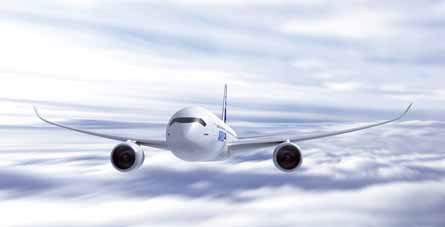Industrial go-ahead imminent for new twinjet family, but Rolls-Royce remains the only engine supplier to commit
As Airbus awaits an imminent industrial go-ahead from EADS for the A350 XWB, it is facing a year's slip in the twinjet's entry-into-service (EIS) target. The manufacturer has also so far failed to enlist General Electric on the programme, leaving Rolls-Royce as the only supplier committed to provide an engine for the new family.
Airbus parent EADS says its directors are "preparing to make a decision" about the A350 XWB "in the weeks to come" and progress is expected by early December.
Although the all-new A350 XWB was unveiled in July at Farnborough, industry sources say the twinjet's basic specification is still not finalised. The industrial go-ahead will enable Airbus to commit large-scale engineering resources to complete this effort.
|
|---|
The entry-into-service target for Airbus's A350 XWB has slipped to no earlier than mid-2013 - a year later than was proposed at its Farnborough launch |
Airbus is believed to be aiming to complete the design freeze for the three-member A350 family (-800, -900 and -1000) in 2008, but in the wake of the airframer's recent production issues, sources say the service-entry target for the first version (-900) has slipped to no earlier than mid-2013 - a year later than proposed at the Farnborough launch.
The manufacturer is also struggling to sign a second engine supplier to compete with R-R on the A350. GE was the lead supplier on the original A350 with its GEnx engine and has indicated it could offer the engine on the two smaller A350 models - but not the -1000 because it would compete with the GE-powered Boeing 777 models. GE confirms it has not yet formally agreed to power any of the A350 variants, but "is still in very active discussions with Airbus" about the -800/900. This means that customers, many of whom originally signed up for the GE-powered A350, currently only have the R-R Trent option.
Airbus declines to comment on the A350 schedule or engine supply situation ahead of the launch decision. The status of the largest A350, the 350-seat -1000, is the least clear, with key potential customer Emirates saying the aircraft is too small. Service entry had been scheduled for 2014, but this is understood to have slipped until at least late 2015.
The A350-1000 is nominally powered by a 95,000lb-thrust (423kN) engine, but Airbus is exploring thrust growth options above 100,000lb for the variant. Sources indicate that discussions held with GE on a possible 105,000lb GEnx derivative have lapsed, leaving only an R-R, and possibly Pratt & Whitney, option.
Fear over future projects A French regional politician has questioned the financial ability of Airbus's first-tier suppliers to cope with the future A320 narrowbody replacement and A350 XWB programmes, having extended themselves so heavily on the delayed A380. Former minister and president of the Midi-Pyrenees region Martin Malvy says Airbus suppliers became heavily indebted between 2001 and 2004 during the industrial ramp-up of the A380. He says there was a 50% increase in medium and long-term borrowing by aerospace suppliers and a 130% increase in short-term borrowing to cover cashflow requirements, with total debt now standing at €400 million ($510 million). Malvy says support such as repayable loans from the French state, normally reserved for first-tier suppliers, should be extended to tiers two and three. He is also calling for a successor to Plan Ader, a €24 million initiative launched in 2001 to develop the region's industrial infrastructure to meet the A380's production needs, with a new plan to meet the challenges posed by Airbus's restructuring initiative, Power8. |
|---|
Source: Flight International

















